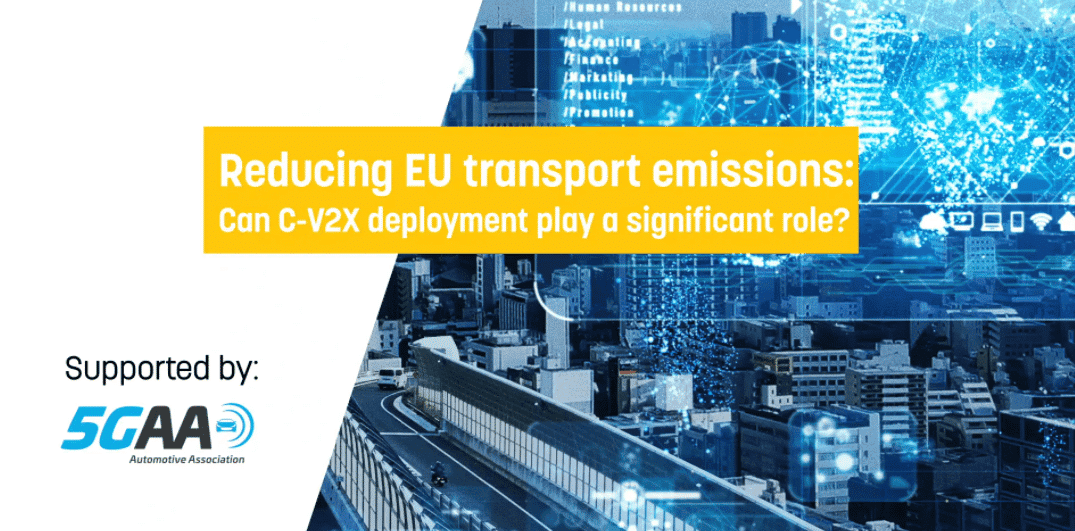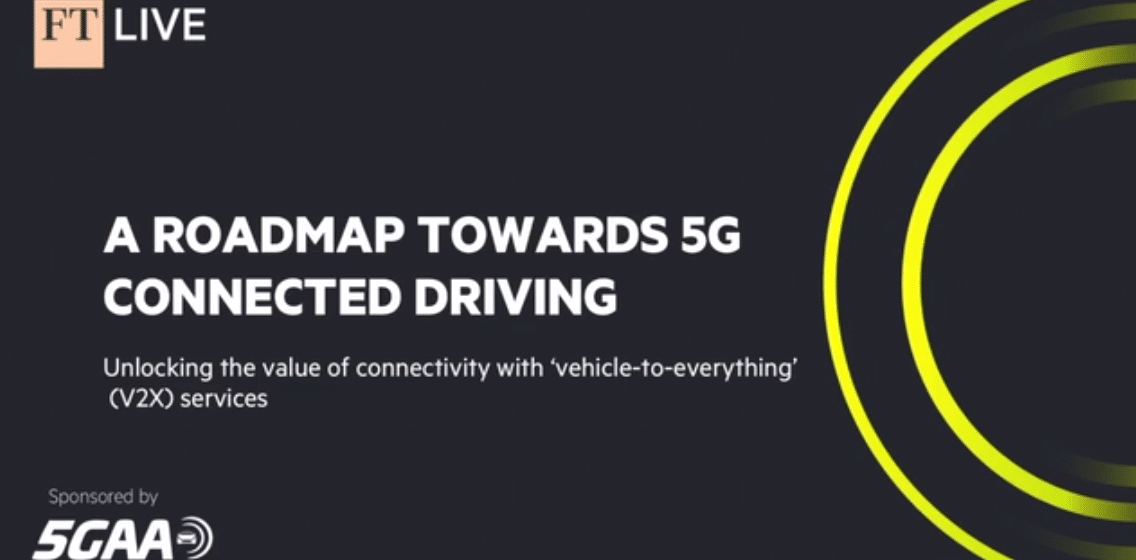
Reducing EU Transport Emissions: Can C-V2X Deployment Play a Significant Role?
On 24 November, Euractiv hosted a debate to assess and discuss the benefits of C-V2X deployment in terms of emission reduction by 2050 in Europe.
TNO, a not-for-profit Dutch research institute, presented new research related to traffic efficiency, and the specific C-V2X functionalities that offer the biggest emission reductions and therefore a contribution to the EU’s climate goals ahead of the comprehensive Strategy for a Sustainable and Smart Mobility (part of the European Green Deal).
The Strategy proposes to match measures to the “ambition to achieve the 90% reduction in emissions by 2050” leveraging “digitalisation and automation, enhancing connectivity to the next level and last, but not least, it will ensure safety and accessibility”.
Read the Study
Watch the highlights
Watch the full event
Reducing EU Transport Emissions: Can C-V2X Deployment Play a Significant Role?
On 24 November, Euractiv hosted a debate to assess and discuss the benefits of C-V2X deployment in terms of emission reduction by 2050 in Europe.
TNO, a not-for-profit Dutch research institute, presented new research related to traffic efficiency, and the specific C-V2X functionalities that offer the biggest emission reductions and therefore a contribution to the EU’s climate goals ahead of the comprehensive Strategy for a Sustainable and Smart Mobility (part of the European Green Deal).
The Strategy proposes to match measures to the “ambition to achieve the 90% reduction in emissions by 2050” leveraging “digitalisation and automation, enhancing connectivity to the next level and last, but not least, it will ensure safety and accessibility”.
Read the Study
Watch the highlights
Watch the full event

Reducing EU Transport Emissions: Can C-V2X Deployment play a Significant Role?
On 24 November 2020, the 5G Automotive Association, in partnership with Euractiv, hosted a debate to discuss how C-V2X can contribute to reducing transport emissions.
To what extent can connected driving, with increasing levels of automation, lead to environmental benefits? To answer this question, 5GAA asked Dutch non-profit organisation TNO to conduct a study into the environmental effects of V2X communication as it is currently used in transport and as it can be used in future implementations.
During the event, the organisation presented the results of the study. These highlighted the specific C-V2X functionalities that offer the biggest emission reductions and therefore a contribution to the EU’s climate goals.
Indeed, at the time of the broadcast, the European Commission was working the Sustainable and Smart Mobility strategy, proposing measures that match the ambition of the recently updated emissions reductions goals. Policymakers aimed to leverage digitalisation and automation to create a more sustainable future for the transport and mobility sector.
Watch the video below to have some highlights of the event.

C-V2X Use Cases and Service Level Requirements Volume I
The present report represents the latest version of the first set of Use Case descriptions (Volume 1 – previously named WAVE1) developed in the context of the 5GAA WG1 work item “Use Case and KPI requirements”. The report introduces and explains the WG1 approach to describe Use Cases and their Service Level Requirements (SLRs). It includes a framework for the Use Case descriptions and a framework for Use Case Service Level Requirements collection. The two frameworks are applied to the Use Cases provided in the 5GAA Board Internal Guidance Document.
Read the full report

Roadmap to 5G Connected Driving – Financial Times Digital Dialogue sponsored by 5GAA
On 20 October 2020, the 5G Automotive Association took part in one of the Financial Times Digital Dialogues moderated by Michael Pooler, Manufacturing Editor at Financial Times.
A successful and insightful session focused on the “Roadmap towards 5G Connected Driving”.
Oliver Bahns, Senior Vice-President Connected Mobility Deutsche Telecom AG, T-Systems, Digital Solutions; Kelei Shen, CTO Harman; and Stephan Durach, Senior Vice President, Connected Company Development, Technical Operations, BMW Group, highlighted the most critical issues around V2X Services.
Some of the topics covered were:
- What are the most prevalent and common features of connectivity currently available in the field of vehicles-to-everything?
- Why is the automotive sector such an attractive prospect for 5G? Why does full connectivity of cars with everything require 5G as opposed to 4G?
- What are the most exciting emerging technological advances in 5G and V2X?
- What are the technological obstacles and how are they being overcome?
Rewatch the full session below.
Roadmap to 5G Connected Driving – Financial Times Digital Dialogue sponsored by 5GAA
On 20 October 2020, the 5G Automotive Association took part in one of the Financial Times Digital Dialogues moderated by Michael Pooler, Manufacturing Editor at Financial Times.
A successful and insightful session focused on the “Roadmap towards 5G Connected Driving”.
Oliver Bahns, Senior Vice-President Connected Mobility Deutsche Telecom AG, T-Systems, Digital Solutions; Kelei Shen, CTO Harman; and Stephan Durach, Senior Vice President, Connected Company Development, Technical Operations, BMW Group, highlighted the most critical issues around V2X Services.
Some of the topics covered were:
- What are the most prevalent and common features of connectivity currently available in the field of vehicles-to-everything?
- Why is the automotive sector such an attractive prospect for 5G? Why does full connectivity of cars with everything require 5G as opposed to 4G?
- What are the most exciting emerging technological advances in 5G and V2X?
- What are the technological obstacles and how are they being overcome?
Rewatch the full session below.

Environmental Benefits of C-V2X
There is increased interest in the potential environmental benefits of C-V2X, given that substantial transport emissions reductions are required to help mitigate climate change, and the upcoming EC Strategy on Sustainable and Smart Mobility which intends to propose matching measures to the “unprecedented ambition to achieve 90% reduction in emissions by 2050”. The question is to what extent connected driving, with increasing levels of automation, can lead to environmental benefits. 5GAA, the 5G Automotive Association, asked TNO to conduct a study into the environmental effects of V2X communication as it is currently used in transport and as it can be used in future implementations.
Read the full study
Presentation of the study

Business Aspects and Requirements of 5G Network slicing (BARNS) Report
5G will help vertical industries to achieve the ‘internet of everything’ vision of ubiquitously connected, highly reliable, ultra-low latency services for a massive number of terminals. Network slicing is considered as one of the key features for 5G allowing in particular to support the different needs of various vertical industries, including the automotive industry. Network slicing is a concept for running multiple logical networks (which could be customised and provided with guaranteed Service Level Agreements, SLAs) as virtually independent business operations on common physical infrastructure.
To limit the scope of this work, it will initially focus on the very basic functions of a mobile network, which are to provide coverage, throughput, and latency for data transmission between the vehicle (UE) and a backend infrastructure (i.e. mobile networks) using the network slicing approach. In further steps, the scope of this work shall be extended from how to use network slicing to tackle the additional functional and operational requirements from the automotive industry and their business implications.
Read the full report

Privacy by Design Aspects of C-V2X
Connected vehicles, as part of the emerging Cooperative Intelligent Transportation Systems (C-ITS) are positioned to transform the future of mobility – a change enabled by the exchange of messages between vehicles and between vehicles and transport infrastructure. As these messages are constantly broadcasting data, including vehicle speed and location, this raises potential concern about how to address privacy and data protection.
In this document, we take a fresh look at the latest technological architectures that feature Privacy by Design. We focus specifically on Cooperative Awareness Messages (CAM) and Decentralised Environmental Notification Messages (DENM), where privacy protection is offered by using pseudonym certificates that do not contain any identifying information. A Public Key Infrastructure (PKI) system takes care of the provision and overall management of the corresponding cryptographic keys. In this document, we review how current PKI system design can help address the risk of tracking from outside and inside attackers, and we identify challenges and privacy risks that remain unresolved. We give some suggestions in terms of future research and conclude the document with general recommendations.
Read the full White Paper

C-V2X Use Cases Volume II: Examples and Service Level Requirements
5G Automotive Association (5GAA) has defined a methodology to describe solution agnostic automotive use cases (UC) and application requirements referred to as Service Level Requirements (SLR).
This White Paper applies the defined methodology to describe use cases, and includes advanced UCs that require complex interactions among vehicles as well as between vehicles and infrastructure in relation to self-driving (autonomous) vehicles. Different road scenarios, actors and service flows are considered in the defined use cases. Detailed analysis of the derived Service Level Requirements is also provided.


